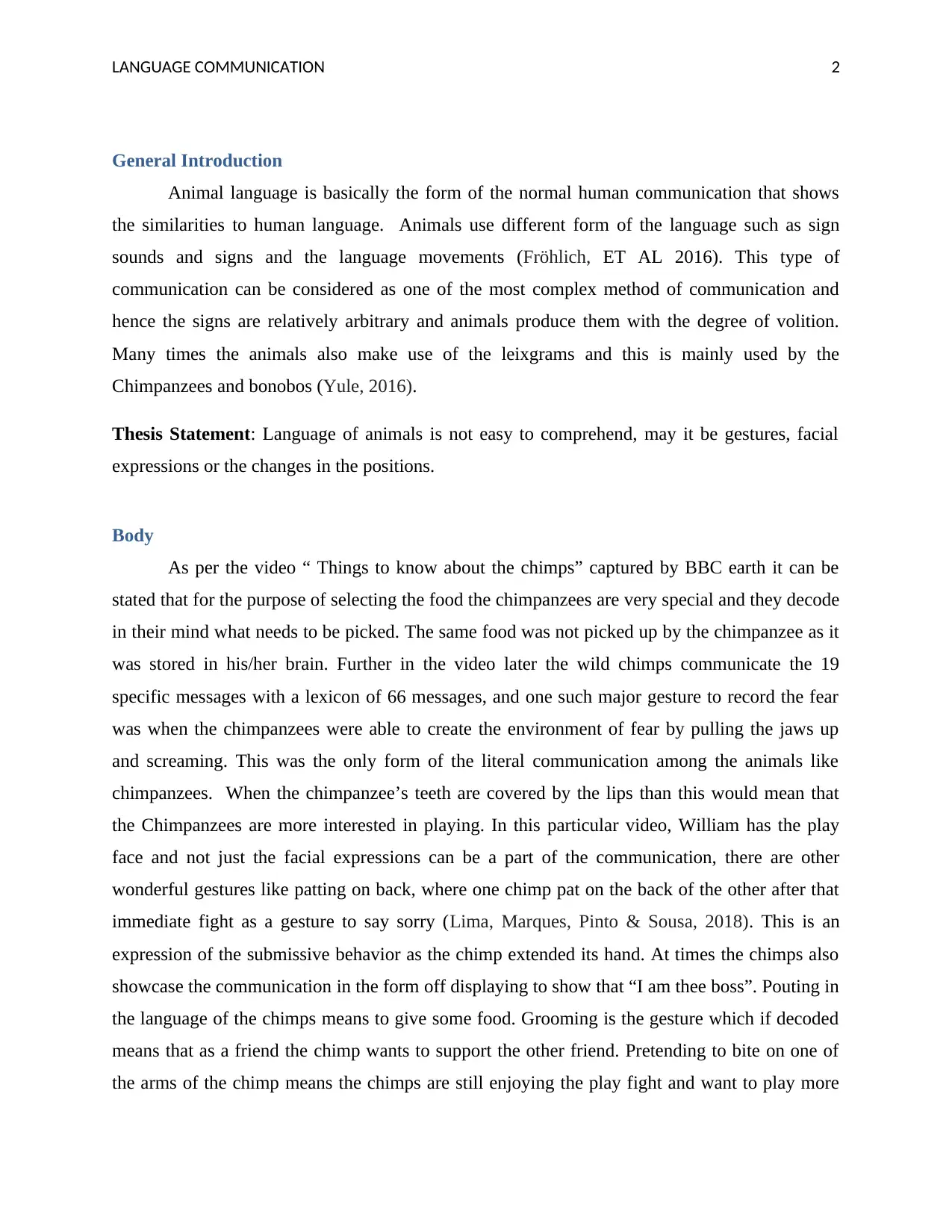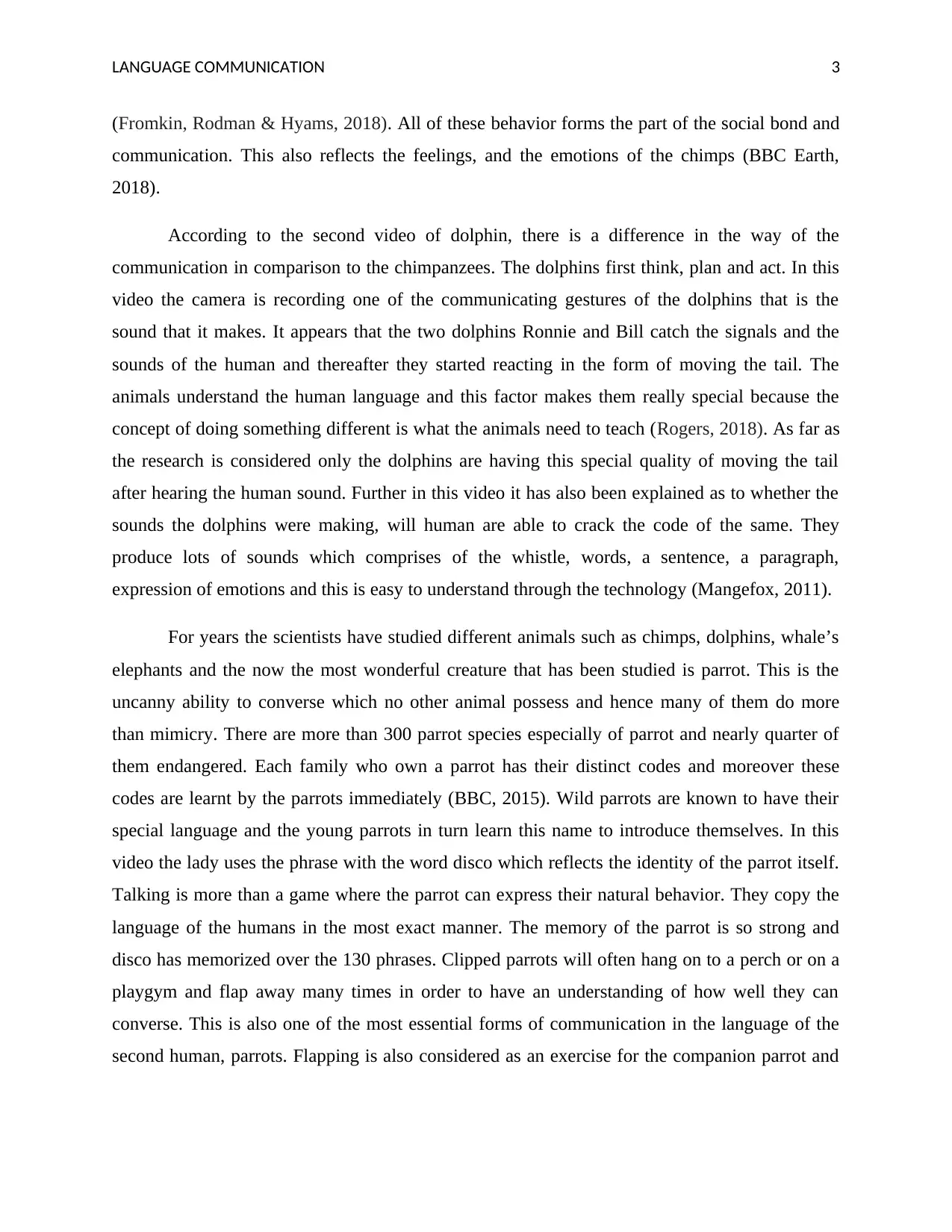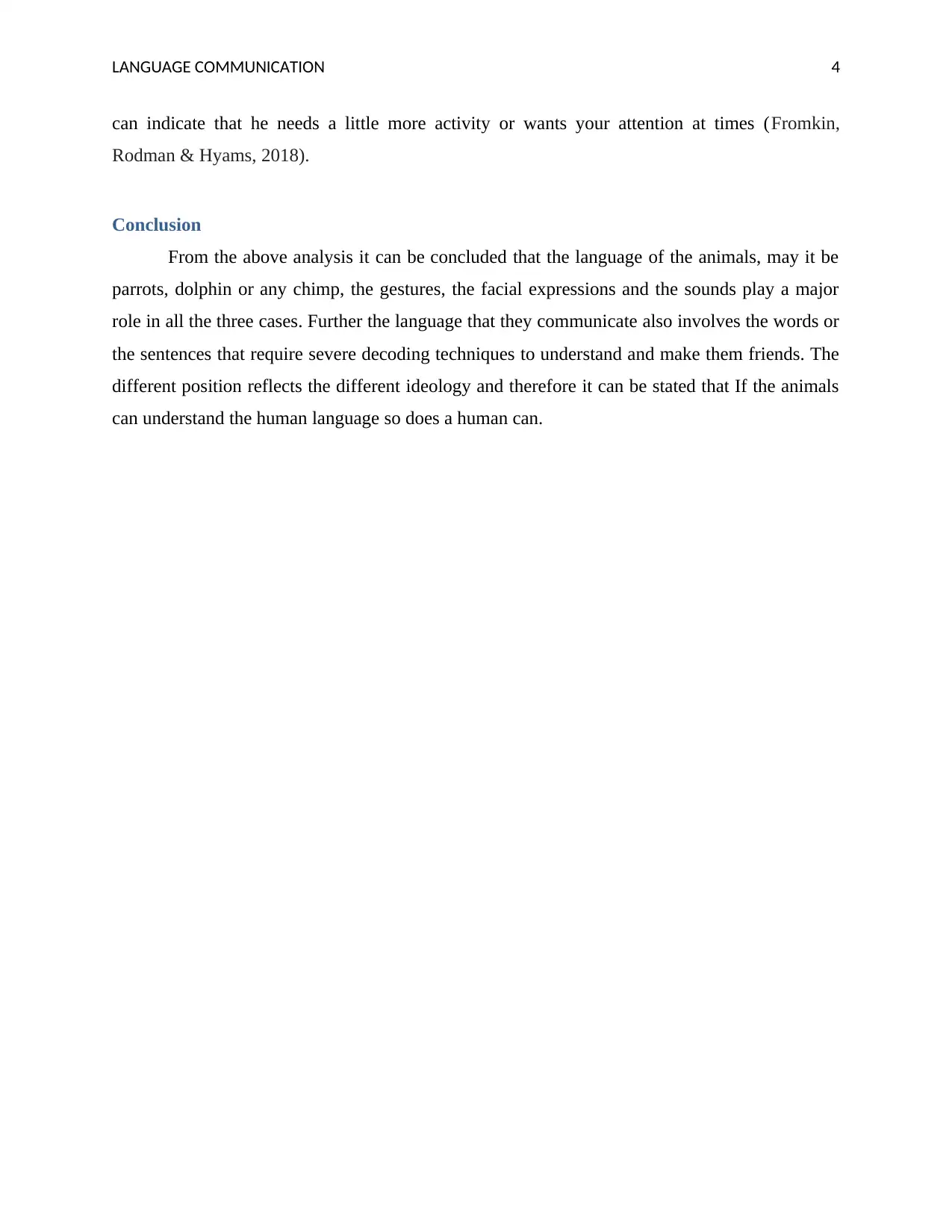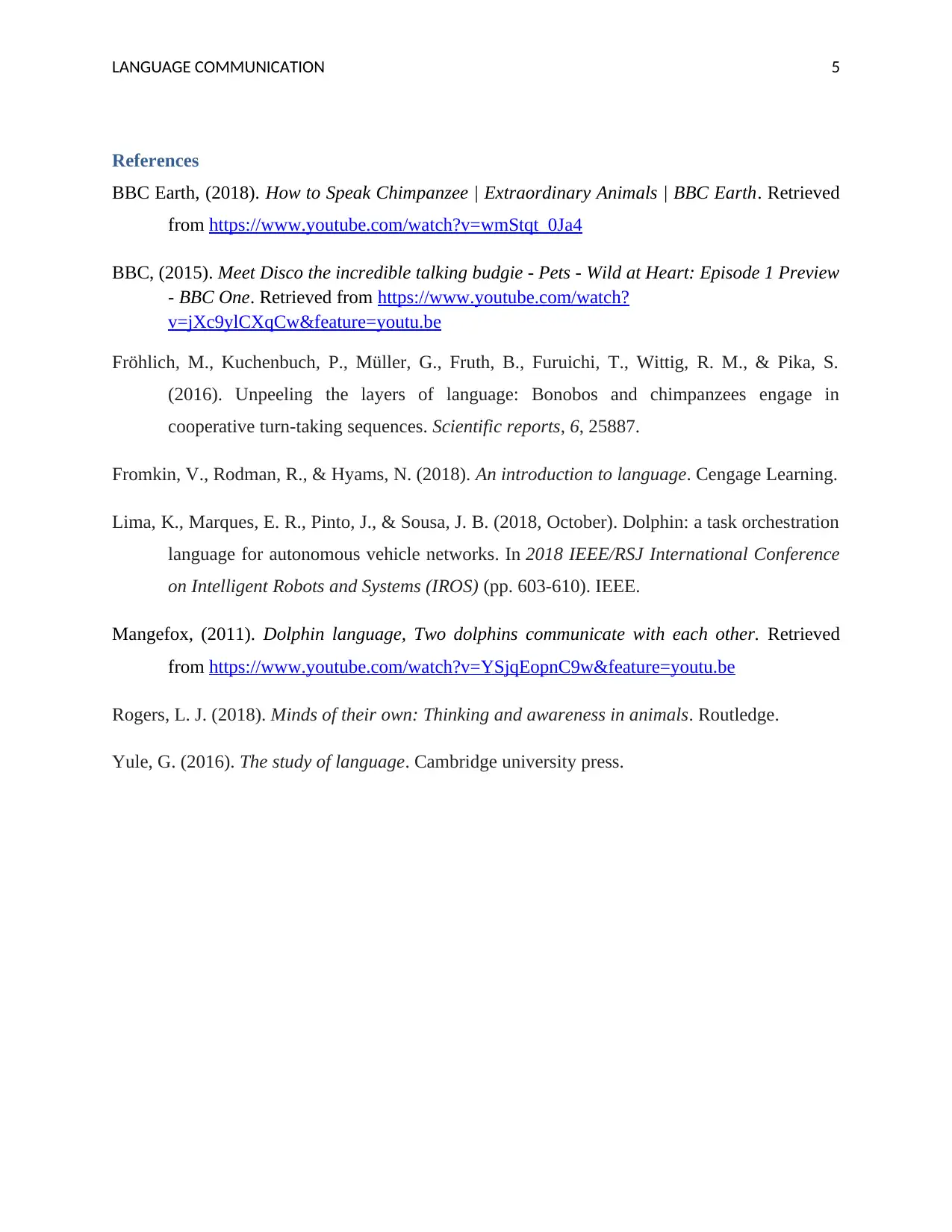Comparative Analysis of Animal Linguistic Behavior with Examples
VerifiedAdded on 2023/04/11
|5
|1154
|404
Essay
AI Summary
This essay examines the extent to which animal behavior can be considered linguistic, drawing upon course readings and YouTube videos featuring chimpanzees, dolphins, and parrots. It begins with an introduction that provides general background information and a thesis statement, followed by a body that describes and explains the design features of language, illustrating them with examples. The essay then compares and contrasts how each animal exhibits or lacks these features in comparison to humans, ultimately determining which animal is most similar to humans in terms of linguistic behavior. The analysis encompasses gestures, facial expressions, and sounds, emphasizing the complexity of animal communication and the decoding techniques required to understand it. The essay concludes by summarizing the main points and stating an overall conclusion that if animals can understand human language, humans can also understand animal language. This assignment is available on Desklib, a platform offering a wide array of study resources for students.

Running head: LANGUAGE COMMUNICATION 1
LANGUAGE COMMUNICATION
LANGUAGE COMMUNICATION
Paraphrase This Document
Need a fresh take? Get an instant paraphrase of this document with our AI Paraphraser

LANGUAGE COMMUNICATION 2
General Introduction
Animal language is basically the form of the normal human communication that shows
the similarities to human language. Animals use different form of the language such as sign
sounds and signs and the language movements (Fröhlich, ET AL 2016). This type of
communication can be considered as one of the most complex method of communication and
hence the signs are relatively arbitrary and animals produce them with the degree of volition.
Many times the animals also make use of the leixgrams and this is mainly used by the
Chimpanzees and bonobos (Yule, 2016).
Thesis Statement: Language of animals is not easy to comprehend, may it be gestures, facial
expressions or the changes in the positions.
Body
As per the video “ Things to know about the chimps” captured by BBC earth it can be
stated that for the purpose of selecting the food the chimpanzees are very special and they decode
in their mind what needs to be picked. The same food was not picked up by the chimpanzee as it
was stored in his/her brain. Further in the video later the wild chimps communicate the 19
specific messages with a lexicon of 66 messages, and one such major gesture to record the fear
was when the chimpanzees were able to create the environment of fear by pulling the jaws up
and screaming. This was the only form of the literal communication among the animals like
chimpanzees. When the chimpanzee’s teeth are covered by the lips than this would mean that
the Chimpanzees are more interested in playing. In this particular video, William has the play
face and not just the facial expressions can be a part of the communication, there are other
wonderful gestures like patting on back, where one chimp pat on the back of the other after that
immediate fight as a gesture to say sorry (Lima, Marques, Pinto & Sousa, 2018). This is an
expression of the submissive behavior as the chimp extended its hand. At times the chimps also
showcase the communication in the form off displaying to show that “I am thee boss”. Pouting in
the language of the chimps means to give some food. Grooming is the gesture which if decoded
means that as a friend the chimp wants to support the other friend. Pretending to bite on one of
the arms of the chimp means the chimps are still enjoying the play fight and want to play more
General Introduction
Animal language is basically the form of the normal human communication that shows
the similarities to human language. Animals use different form of the language such as sign
sounds and signs and the language movements (Fröhlich, ET AL 2016). This type of
communication can be considered as one of the most complex method of communication and
hence the signs are relatively arbitrary and animals produce them with the degree of volition.
Many times the animals also make use of the leixgrams and this is mainly used by the
Chimpanzees and bonobos (Yule, 2016).
Thesis Statement: Language of animals is not easy to comprehend, may it be gestures, facial
expressions or the changes in the positions.
Body
As per the video “ Things to know about the chimps” captured by BBC earth it can be
stated that for the purpose of selecting the food the chimpanzees are very special and they decode
in their mind what needs to be picked. The same food was not picked up by the chimpanzee as it
was stored in his/her brain. Further in the video later the wild chimps communicate the 19
specific messages with a lexicon of 66 messages, and one such major gesture to record the fear
was when the chimpanzees were able to create the environment of fear by pulling the jaws up
and screaming. This was the only form of the literal communication among the animals like
chimpanzees. When the chimpanzee’s teeth are covered by the lips than this would mean that
the Chimpanzees are more interested in playing. In this particular video, William has the play
face and not just the facial expressions can be a part of the communication, there are other
wonderful gestures like patting on back, where one chimp pat on the back of the other after that
immediate fight as a gesture to say sorry (Lima, Marques, Pinto & Sousa, 2018). This is an
expression of the submissive behavior as the chimp extended its hand. At times the chimps also
showcase the communication in the form off displaying to show that “I am thee boss”. Pouting in
the language of the chimps means to give some food. Grooming is the gesture which if decoded
means that as a friend the chimp wants to support the other friend. Pretending to bite on one of
the arms of the chimp means the chimps are still enjoying the play fight and want to play more

LANGUAGE COMMUNICATION 3
(Fromkin, Rodman & Hyams, 2018). All of these behavior forms the part of the social bond and
communication. This also reflects the feelings, and the emotions of the chimps (BBC Earth,
2018).
According to the second video of dolphin, there is a difference in the way of the
communication in comparison to the chimpanzees. The dolphins first think, plan and act. In this
video the camera is recording one of the communicating gestures of the dolphins that is the
sound that it makes. It appears that the two dolphins Ronnie and Bill catch the signals and the
sounds of the human and thereafter they started reacting in the form of moving the tail. The
animals understand the human language and this factor makes them really special because the
concept of doing something different is what the animals need to teach (Rogers, 2018). As far as
the research is considered only the dolphins are having this special quality of moving the tail
after hearing the human sound. Further in this video it has also been explained as to whether the
sounds the dolphins were making, will human are able to crack the code of the same. They
produce lots of sounds which comprises of the whistle, words, a sentence, a paragraph,
expression of emotions and this is easy to understand through the technology (Mangefox, 2011).
For years the scientists have studied different animals such as chimps, dolphins, whale’s
elephants and the now the most wonderful creature that has been studied is parrot. This is the
uncanny ability to converse which no other animal possess and hence many of them do more
than mimicry. There are more than 300 parrot species especially of parrot and nearly quarter of
them endangered. Each family who own a parrot has their distinct codes and moreover these
codes are learnt by the parrots immediately (BBC, 2015). Wild parrots are known to have their
special language and the young parrots in turn learn this name to introduce themselves. In this
video the lady uses the phrase with the word disco which reflects the identity of the parrot itself.
Talking is more than a game where the parrot can express their natural behavior. They copy the
language of the humans in the most exact manner. The memory of the parrot is so strong and
disco has memorized over the 130 phrases. Clipped parrots will often hang on to a perch or on a
playgym and flap away many times in order to have an understanding of how well they can
converse. This is also one of the most essential forms of communication in the language of the
second human, parrots. Flapping is also considered as an exercise for the companion parrot and
(Fromkin, Rodman & Hyams, 2018). All of these behavior forms the part of the social bond and
communication. This also reflects the feelings, and the emotions of the chimps (BBC Earth,
2018).
According to the second video of dolphin, there is a difference in the way of the
communication in comparison to the chimpanzees. The dolphins first think, plan and act. In this
video the camera is recording one of the communicating gestures of the dolphins that is the
sound that it makes. It appears that the two dolphins Ronnie and Bill catch the signals and the
sounds of the human and thereafter they started reacting in the form of moving the tail. The
animals understand the human language and this factor makes them really special because the
concept of doing something different is what the animals need to teach (Rogers, 2018). As far as
the research is considered only the dolphins are having this special quality of moving the tail
after hearing the human sound. Further in this video it has also been explained as to whether the
sounds the dolphins were making, will human are able to crack the code of the same. They
produce lots of sounds which comprises of the whistle, words, a sentence, a paragraph,
expression of emotions and this is easy to understand through the technology (Mangefox, 2011).
For years the scientists have studied different animals such as chimps, dolphins, whale’s
elephants and the now the most wonderful creature that has been studied is parrot. This is the
uncanny ability to converse which no other animal possess and hence many of them do more
than mimicry. There are more than 300 parrot species especially of parrot and nearly quarter of
them endangered. Each family who own a parrot has their distinct codes and moreover these
codes are learnt by the parrots immediately (BBC, 2015). Wild parrots are known to have their
special language and the young parrots in turn learn this name to introduce themselves. In this
video the lady uses the phrase with the word disco which reflects the identity of the parrot itself.
Talking is more than a game where the parrot can express their natural behavior. They copy the
language of the humans in the most exact manner. The memory of the parrot is so strong and
disco has memorized over the 130 phrases. Clipped parrots will often hang on to a perch or on a
playgym and flap away many times in order to have an understanding of how well they can
converse. This is also one of the most essential forms of communication in the language of the
second human, parrots. Flapping is also considered as an exercise for the companion parrot and
⊘ This is a preview!⊘
Do you want full access?
Subscribe today to unlock all pages.

Trusted by 1+ million students worldwide

LANGUAGE COMMUNICATION 4
can indicate that he needs a little more activity or wants your attention at times (Fromkin,
Rodman & Hyams, 2018).
Conclusion
From the above analysis it can be concluded that the language of the animals, may it be
parrots, dolphin or any chimp, the gestures, the facial expressions and the sounds play a major
role in all the three cases. Further the language that they communicate also involves the words or
the sentences that require severe decoding techniques to understand and make them friends. The
different position reflects the different ideology and therefore it can be stated that If the animals
can understand the human language so does a human can.
can indicate that he needs a little more activity or wants your attention at times (Fromkin,
Rodman & Hyams, 2018).
Conclusion
From the above analysis it can be concluded that the language of the animals, may it be
parrots, dolphin or any chimp, the gestures, the facial expressions and the sounds play a major
role in all the three cases. Further the language that they communicate also involves the words or
the sentences that require severe decoding techniques to understand and make them friends. The
different position reflects the different ideology and therefore it can be stated that If the animals
can understand the human language so does a human can.
Paraphrase This Document
Need a fresh take? Get an instant paraphrase of this document with our AI Paraphraser

LANGUAGE COMMUNICATION 5
References
BBC Earth, (2018). How to Speak Chimpanzee | Extraordinary Animals | BBC Earth. Retrieved
from https://www.youtube.com/watch?v=wmStqt_0Ja4
BBC, (2015). Meet Disco the incredible talking budgie - Pets - Wild at Heart: Episode 1 Preview
- BBC One. Retrieved from https://www.youtube.com/watch?
v=jXc9ylCXqCw&feature=youtu.be
Fröhlich, M., Kuchenbuch, P., Müller, G., Fruth, B., Furuichi, T., Wittig, R. M., & Pika, S.
(2016). Unpeeling the layers of language: Bonobos and chimpanzees engage in
cooperative turn-taking sequences. Scientific reports, 6, 25887.
Fromkin, V., Rodman, R., & Hyams, N. (2018). An introduction to language. Cengage Learning.
Lima, K., Marques, E. R., Pinto, J., & Sousa, J. B. (2018, October). Dolphin: a task orchestration
language for autonomous vehicle networks. In 2018 IEEE/RSJ International Conference
on Intelligent Robots and Systems (IROS) (pp. 603-610). IEEE.
Mangefox, (2011). Dolphin language, Two dolphins communicate with each other. Retrieved
from https://www.youtube.com/watch?v=YSjqEopnC9w&feature=youtu.be
Rogers, L. J. (2018). Minds of their own: Thinking and awareness in animals. Routledge.
Yule, G. (2016). The study of language. Cambridge university press.
References
BBC Earth, (2018). How to Speak Chimpanzee | Extraordinary Animals | BBC Earth. Retrieved
from https://www.youtube.com/watch?v=wmStqt_0Ja4
BBC, (2015). Meet Disco the incredible talking budgie - Pets - Wild at Heart: Episode 1 Preview
- BBC One. Retrieved from https://www.youtube.com/watch?
v=jXc9ylCXqCw&feature=youtu.be
Fröhlich, M., Kuchenbuch, P., Müller, G., Fruth, B., Furuichi, T., Wittig, R. M., & Pika, S.
(2016). Unpeeling the layers of language: Bonobos and chimpanzees engage in
cooperative turn-taking sequences. Scientific reports, 6, 25887.
Fromkin, V., Rodman, R., & Hyams, N. (2018). An introduction to language. Cengage Learning.
Lima, K., Marques, E. R., Pinto, J., & Sousa, J. B. (2018, October). Dolphin: a task orchestration
language for autonomous vehicle networks. In 2018 IEEE/RSJ International Conference
on Intelligent Robots and Systems (IROS) (pp. 603-610). IEEE.
Mangefox, (2011). Dolphin language, Two dolphins communicate with each other. Retrieved
from https://www.youtube.com/watch?v=YSjqEopnC9w&feature=youtu.be
Rogers, L. J. (2018). Minds of their own: Thinking and awareness in animals. Routledge.
Yule, G. (2016). The study of language. Cambridge university press.
1 out of 5
Your All-in-One AI-Powered Toolkit for Academic Success.
+13062052269
info@desklib.com
Available 24*7 on WhatsApp / Email
![[object Object]](/_next/static/media/star-bottom.7253800d.svg)
Unlock your academic potential
Copyright © 2020–2025 A2Z Services. All Rights Reserved. Developed and managed by ZUCOL.
